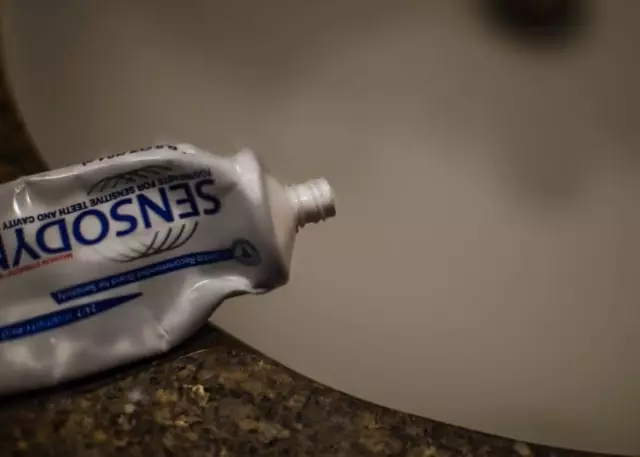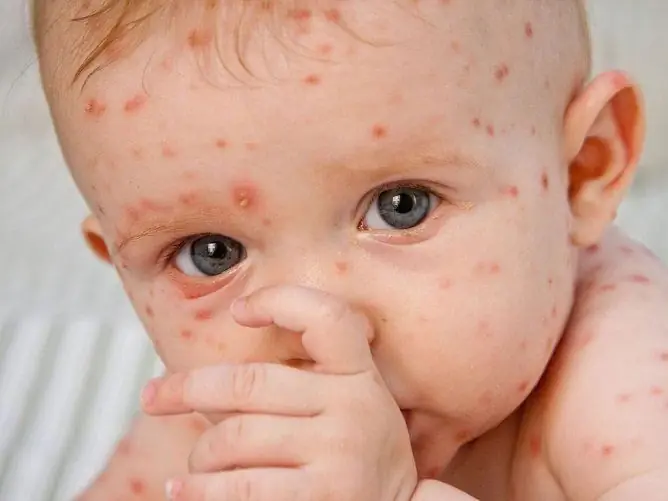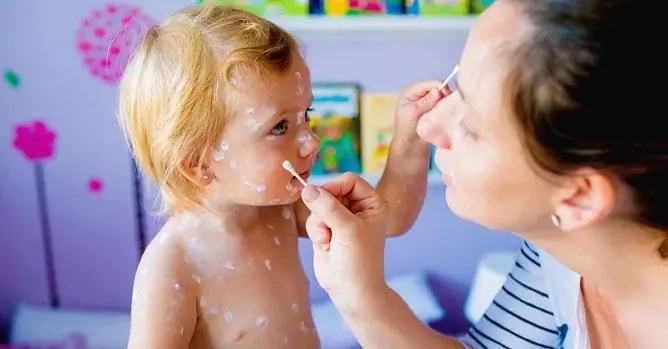- Author Rachel Wainwright [email protected].
- Public 2024-01-15 19:51.
- Last modified 2025-11-02 20:14.
How to relieve itching with chickenpox in a child: the most effective drugs
The content of the article:
- Characteristics of chickenpox
- The clinical picture with chickenpox
- General recommendations for relief
-
Chickenpox treatment
-
Drug therapy
- Sedatives
- Antihistamines
- Topical preparations
- Means for relieving itching on mucous membranes
- Traditional medicine methods
-
- Video
How to relieve itching with chickenpox in a child is a frequent question of the parents of every sick baby. After all, itching and scratching is not only an unpleasant symptom of the disease, but also a potential threat of infectious complications.

Chickenpox is characterized by an itchy skin rash
Itching is an unpleasant sensation on the skin, mucous membranes, upper respiratory tract or conjunctiva that causes an intense need to scratch.
In the nerve endings there are special neurons, which are acted upon by substances - histamine, prostaglandins and kallikrein, released when cells are destroyed by the chickenpox virus. Therefore, the more elements of the rash, the stronger the itching sensation.
Characteristics of chickenpox
Chickenpox is an extremely contagious childhood infection caused by the herpesvirus of the Herpesviridae family - Varicella Zoster, which occurs with profuse rashes on the skin and mucous membranes, causing many inconveniences to the patient. The virus is transmitted only from person to person by droplets or contact. The chances of becoming infected after contact with a sick person are greater than 90%.

The development of chickenpox is caused by the Varicella Zoster virus
The source of infection with chickenpox is a sick person 6-7 hours before the onset of symptoms and up to 5-6 days after the last dripping. The peak incidence occurs at the age of 2-10 years. Chickenpox is rare among teenagers.
Varicellavirus, getting on the mucous membranes of the child, quickly penetrates into the epithelial cells, multiplies and accumulates. Then, breaking the cell, it enters the bloodstream and spreads throughout the body. The virus shows tropism to the skin and the nervous system.
The clinical picture with chickenpox
The disease begins with a sharp rise in body temperature. Some children may have weakness, drowsiness, loss of appetite, and nausea.
During the first 24 hours after the onset of the fever, rashes appear on the skin, which are accompanied by intense itching.
Stages of the chickenpox rash:
| Rash element | Description |
| Spot | Painless, round, unconsolidated redness of the skin, the appearance of which is associated with local expansion of the capillaries |
| Papule | Is a bump that rises above the surface of the skin |
| Vesicle (vesicle) | A cavity surface element that contains serous fluid inside. The vesicle is single-chambered, has a thin cover. Looks like a dewdrop surrounded by a reddish rim |
| Pustule | Vesicle with a cloudy liquid inside and a more compacted tire |
| Crust | Covers the healing site. It is a dense brown mass formed from a secreted vesicle or pustule |
For rashes with chickenpox, false polymorphism is characteristic: all elements of the rash are present in one area of the skin at once.
New vesicles appear in waves for 4-6 days. This process is accompanied by an increase in the intensity of itching. Unpleasant sensations are especially intensified in the evening, when in contact with hard linen, low humidity in the room.
Babies with chickenpox react to rashes with anxiety, sleep disturbances, tearfulness, and refusal to breastfeed.
General recommendations for relief
General recommendations on how to relieve itching with chickenpox in a child:
- choose underwear made from natural fabrics (cotton);
- change underwear and bed linen daily;
- avoid long water procedures (no more than 10-20 minutes);
- do not wrap the child (overheating and sweat increase the symptom);
- do not use hard washcloths and towels;
- do not use detergents that dry the skin;
- humidify the air in the house;
- limit physical activity;
- avoid stress and anxiety;
- do not feed hot or spicy food, drinks;
- try to interrupt the cycle "itching - scratching - itching" using a napkin soaked in cold water or trying to distract the child;
- cut your nails short.
In infants, to reduce itching and prevent scratching, you can use swaddling or "scratching" on the handles during sleep.
Chickenpox treatment
Chickenpox refers to diseases that do not require medication support in case of mild course. The main directions of treatment:
- taking Acyclovir (with severe course, immunodeficiency, complications);
- decreased fever;
- relief of itching;
- prevention of bacterial skin infection.
To reduce the temperature, it is recommended to take Paracetamol in age-related doses.
Drug therapy
Sedatives
Constant itching makes the child feel stressed, anxious, and leads to sleep disturbance. This increases sweating, histamine release, and further increases discomfort. A vicious circle is forming.

Peppermint tea can be used as a sedative
Children's soothing teas with mint and lemon balm help to calm the child's nervous system.
For older children, you can use Valerian tablets, motherwort tincture, Tenoten, Notta.
Before taking any drug, be sure to consult your doctor.
Antihistamines
This group of drugs reduces the rate of release of substances that provoke itching (histamine, kallikrein). The doctor determines the dose and duration of treatment (on average, no more than 7 days).

Antihistamines help relieve itching.
Preference is given to second and third generation drugs:
- Fenistil;
- Loratadine;
- Erius;
- Cetrin;
- Suprastin;
- Tavegil.
Topical preparations
To treat the body with chickenpox, special ointments, lotions, creams, gels are used.
Local remedies used during chickenpox:
| Name | Release form | Application features |
| Fenistil | cream, gel, emulsion |
Antihistamine, antipruritic and anesthetic effect Apply 2-4 times a day. In young children, it is not recommended to lubricate large areas of the body. |
| Acyclovir | ointment, cream |
Local form of antiviral drug. It is prescribed for severe chickenpox in children over 3 years old Apply to skin 5 times a day (every 4 hours). The course of treatment is 5-10 days |
| Psilo balm | gel |
Diphenhydramine, which is part of the drug, has an anti-allergic effect Can be used by children from 2 years of age. Rub a strip of gel, 3-5 cm long, in an equal layer over an area from the palm of your hand 3-4 times a day |
| Tsindol | suspension |
Contains glycerin, zinc, talc, starch. Has an antiseptic, drying effect Apply to the skin with a tampon or cotton swab the required number of times |
| PoxClean | hydrogel |
Consists of a complex of herbs, panthenol and moisturizers Apply to the skin with a thin layer 3 times a day. Do not use for more than 1 month. Allowed for children from 2 years old |
| Calamine | lotion |
A skin care cosmetic containing calamine and zinc oxide. The lotion removes irritation, inflammation, dries up, forms a protective barrier Apply to the skin with a cotton pad, gently lubricating parts of the body, wait until completely dry |
| Gistan | cream |
Herbal medicine to relieve discomfort Smear a thin layer on the affected areas of the body several times a day |
Means for relieving itching on mucous membranes
It is not only the skin that can itch in a child with chickenpox. Vesicles in the mouth and nasopharynx cause severe discomfort. Regular creams and ointments cannot be used on these areas.
Agents approved for use on mucous membranes:
- chamomile tincture;
- a weak solution of potassium permanganate;
- sea buckthorn oil;
- Chlorphilipt;
- Miramistin.
Traditional medicine methods
You can find many advice from traditional medicine in the fight against itching with chickenpox. But not all of them are effective and safe.
The first method of traditional medicine that helps with itching is warm baths with the addition of various substances:
- decoction of chamomile;
- starch;
- soda, previously quenched with vinegar;
- oat flour;
- lavender oil;
- a weak solution of potassium permanganate;
- infusion of a series.
Also, to get rid of itching and relieve the condition, you can make lotions with potato starch, bergamot and olive oil.
A rash with chickenpox gives the child great discomfort. But it is worth remembering that the irresistible urge to itch will pass in a few days. You need to try to provide the baby with comfortable conditions at home and take proper care of the skin.
Video
We offer for viewing a video on the topic of the article.

Anna Kozlova Medical journalist About the author
Education: Rostov State Medical University, specialty "General Medicine".
Found a mistake in the text? Select it and press Ctrl + Enter.






